Rosa damascena is one of the oldest roses in the world with a history as ancient as Biblical times. It is a popular plant in the beauty industry. People also refer to it as Damask rose, Rose of Castile, and Gole Mohammadi. Apart from its use as an ornamental plant in gardens and houses, Damask rose is principally cultivated for use in beauty, perfume, food, and medicinal products.
What is damask rose?
From erect shrubs to climbing stems armed with thick or thin prickles, a variety of roses are found in every part of the world. The plant can bear roses as small as the nail of a thumb, or as large as grandiflora roses. Thousands of years of hybridization has produced many different varieties of roses.
Although many types of roses are known for their fragrance and beauty, a more popular variety is Damask rose (Rosa damascena), which is widely grown in Turkey, Pakistan, Syria, Bulgaria, Iran, China, Uzbekistan, and India. It is also the most important species of Rosaceae family – the rose family.
There are two groups of damask roses:
- Summer Damask: It blooms in summer.
- Autumn Damask (four season Damask): It blooms in summer and fall.
Damask roses grow in many colours ranging from white to deep pink. The highly fragrant blossom of these roses puts them in the spotlight for the perfume industry. They are also used in medicine, skincare, and food industry.
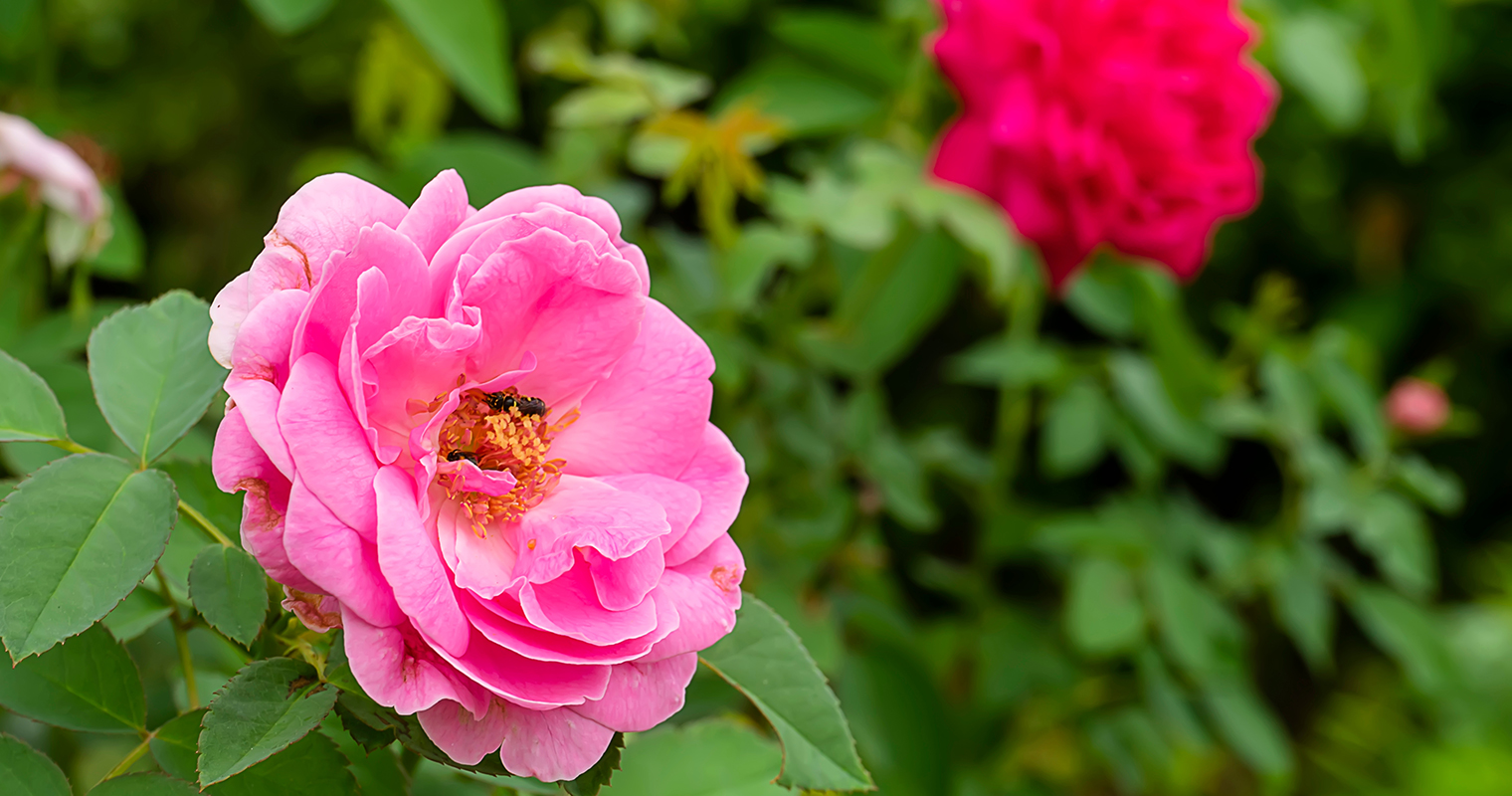
History of damask rose
There are 4,828 species of Rosaceae, Rosa damascena being a popular one. Evidence shows that Rosaceae dates back to the late 7th century AD. In fact, some fossils of rose found in the United States are as old as 30 million years.
Damask rose is believed to have originated from the Middle East, whereas some pieces of evidence suggest that rose water was first introduced in Iran – of course, the land was not known as Iran back then. Additionally, rose essential oil created from Damask rose is believed to have originated in Greece.
Damask rose is worldwide famous and is cultivated across the globe. The high-cultivation areas include Bulgaria, Turkey, India, Europe, China, Pakistan, and Iran. The largest cultivator of Damask rose is Iran where Kashan, Fars, and Azerbaijan are the major areas of cultivation. Iran was also the major producer and exporter of rose oil until the 16th century.
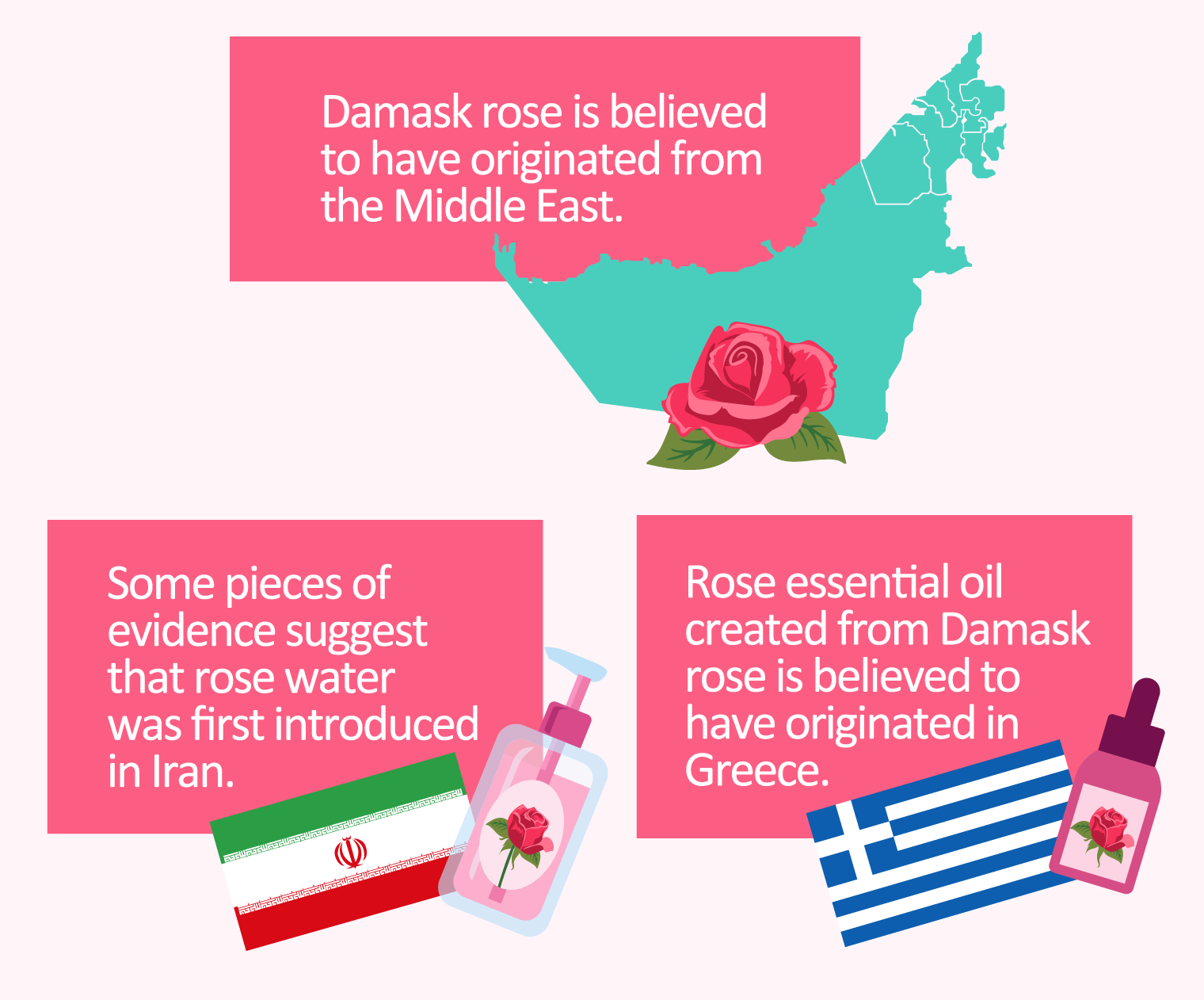
Traditional uses of damask rose
Damask rose is traditionally used for treating conditions like
- Abdominal pain
- Chest pain
- Excessive menstrual bleeding
- Digestive issues
- Cough
- Constipation
- Wound healing

In ancient medicine, damask rose was also used for strengthening of the heart. Moreover, it is believed that rose oil reduces depression, anxiety, and stress.
Chemical components of damask rose
Rosa damascena owes its benefits to numerous chemical components found in it. Following compounds are found in Damask rose:
- anthocyanins
- citrenellol
- disiloxane
- flavonoids
- gallic acid
- carboxylic acid
- heneicosane
- myrcene
- quercetin
- geranial
- nerol
- kaempferol
- vitamin C
Products created from damask rose
Different products in a variety of industries contain damask rose. Major products are as follows:
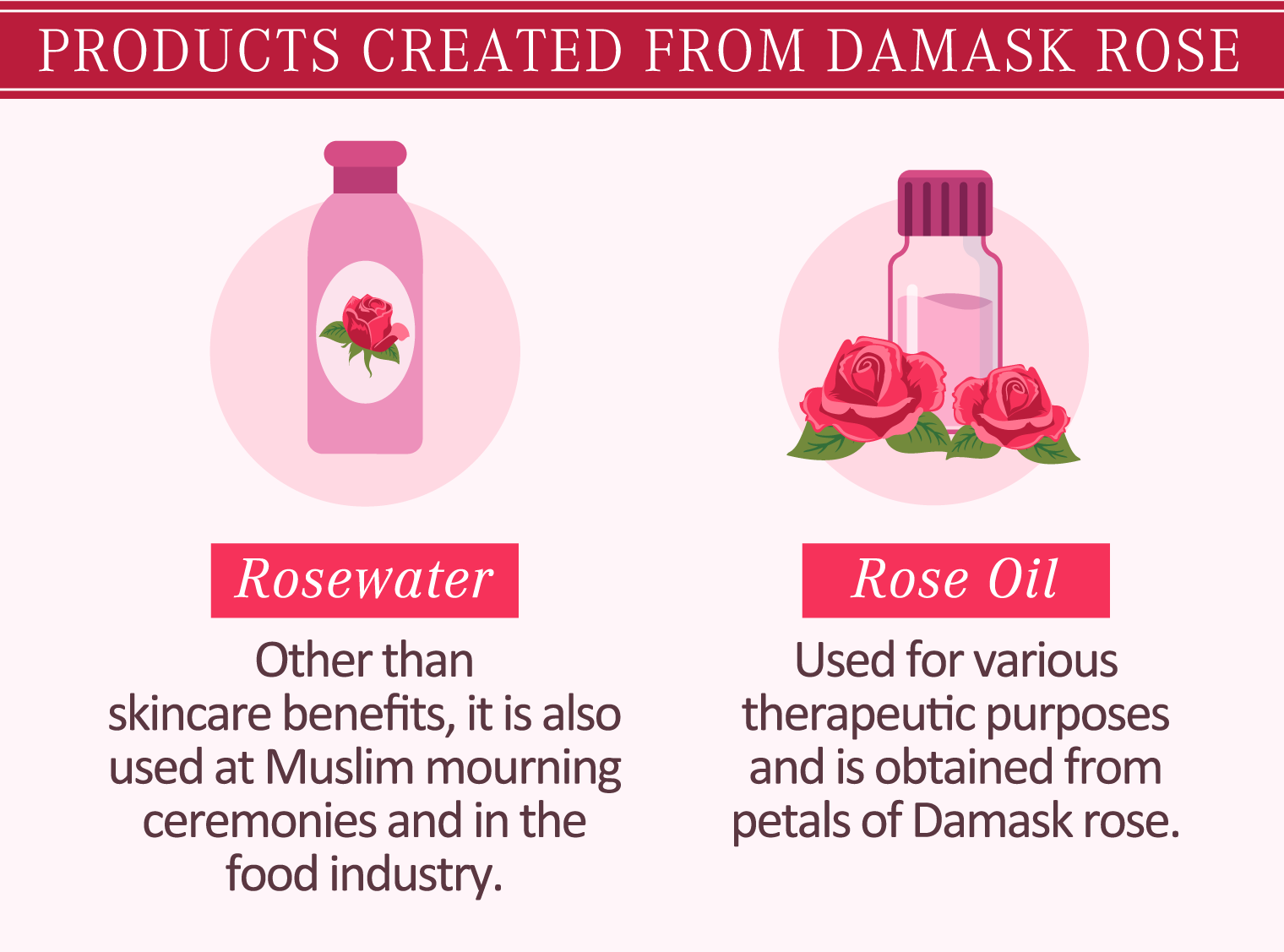
Rose water
Other than numerous skincare benefits of rose water, it is common in religious ceremonies, especially at mourning ceremonies of the Muslim world. Rose water also plays a part in the food industry.
Method of producing rose water
The quality of rose water is dependent on its mode of production. There are many DIY recipes for making rose water, but they do not create a high-quality product. A simple way is to mix rose oil with some distilled water. The resulting mixture is not authentic rose water, and it is still missing on a variety of valuable ingredients.
A professional way of rose water production is through steam-distillation of fresh damask rose petals.
Steam distillation is the distillation of liquid in a current of steam, used especially to purify liquids that are not very volatile and are immiscible with water.
This process creates high-quality rose water that can produce all the claimed benefits. Kashan is by far the best-quality producer of rose water.
Rose oil
Rose oil is used for various therapeutic purposes. It is a volatile oil obtained from fresh flower petals of Damask rose. This pale and semisolid oil is created through a labour-intensive process under carefully controlled conditions. Due to a low oil content in the roses, rose oil requires 3000 parts of flowers to yield one part of the oil.
Damask roses grown in Bulgaria are especially popular. One ounce of Bulgarian rose oil is produced from 60,000 rose blossoms. It is called as “Liquid Gold of Bulgaria”, as an ounce of Bulgarian rose oil is more expensive than an ounce of real gold.
The difficulty of the extraction procedure along with the required number of flowers for 1 mL of rose oil makes it a highly expensive, yet a useful oil in the world. Despite the high price tag, rose oil remains popular.
Methods of producing rose oil
There are three main processes for rose oil production.
- Steam distillation
- Solvent extraction
- Carbon dioxide extraction
Steam distillation:
It is a two-stage process. It involves firing a mixture of roses and water in large stills made of copper for 60-105 minutes. The high temperature results in vaporized water and rose oil exiting the still, and they collect in a condensing apparatus and eventually, in a flask. This distillation produces concentrated oil which makes up to 20% of the rose oil.

Condensed water along the oil in the flask undergoes distillation to yield water-soluble fractions of rose oil where the mixture of the two products (concentrated oil and water-soluble fractions of rose oil) constitutes rose oil, or better known as rosewater.
A few other names for rose essential oil are:
- rose otto
- attar of rose
- rose essence
Solvent extraction
A solvent, such as hexane, helps to agitate flowers in a vat. This process draws out the aromatic components as well as soluble substances like pigment and wax. Vacuum processing removes the solvent from the extract for re-use. The remaining mass, known as concrete, has a waxy feature. Mixing the concrete with alcohol helps to dissolve aromatic constituents, leaving behind wax and other substances. As the alcohol evaporates, the remnants of the finished product, or rose absolute, sit in the vat and may require further processing to remove impurities.
Carbon dioxide extraction
This method combines the best aspects of steam distillation and solvent extraction methods. Carbon dioxide extraction requires CO2 supercritical fluid to extract the aromatics from roses.
CO2 supercritical fluid: Putting carbon dioxide under high pressure (at least 73,900mb) and at a high temperature (32.0 °C) allows it to convert into a supercritical fluid, which has solvation properties of a liquid and permeation properties of a gas.
Carbon dioxide extraction extracts a wide variety of compounds rendering the extract more concentrated and close to the original. As a result, the final product contains no traces of carbon dioxide. It will require expensive equipment to carry out this process.
Dried flowers
Dried damask roses generate an edible form of the petals, which help to resolve digestive issues. Iranian people also use dried rose petals with yoghurt.
Other products
Other products made from Damask rose include:
- Hydrosol extractions
- Chloroform extracts
- Absolute extractions
- Aqueous extractions
- Ethanolic extracts
Of these, ethanol, chloroform, and aqueous extracts are common in research purposes.
Health benefits of damask rose
Damask rose has many health benefits due to its antimicrobial effects, anti-inflammatory properties, laxative effects, ophthalmic uses, and hypnotic effects.
Benefits of rose water
Rose water has been in use since the Middle Ages. Historicists claim that rose water originated in the land we call as Iran today. The uses of rose water are not only limited to beauty products, but in thefood industry as well. There are immense benefits of this incredible water, including the following.
Rose water soothes the skin
Rose water has anti-inflammatory properties. It is used as at-home-remedy to soothe the skin irritation caused by rosacea, eczema, and other skin conditions.

Rose water has pore tightening astringent properties
Rose water has impressive toning and astringent effect on cells and capillaries, which makes it a popular choice as a toner ingredient.
Rose water heals wounds
The antiseptic (substances that slow down or stop bacterial growth) and antibacterial properties of rose water make it a desirable liquid to heal wounds faster. The antibacterial action fights bacteria and cleans infection from cuts and burns.
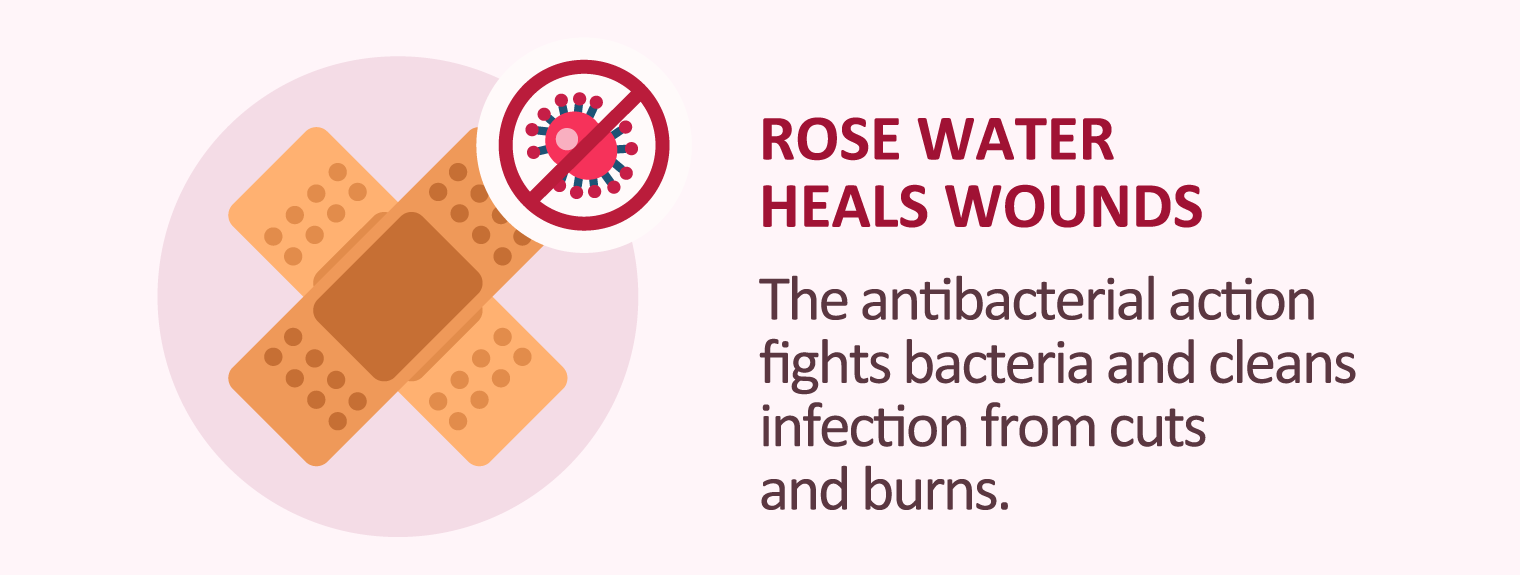
Rose water contains antioxidants
As the name indicates, antioxidants inhibit oxidation – the chemical process that produces free radicals, which then lead to a chain of chemical reactions that may damage the cells. This damage can eventually present as cancer, atherosclerosis, or even vision loss. Antioxidants prevent or delay this cell damage by neutralizing the free radicals.
A number of highly effective antioxidants are found in rose water. Therefore, using rose water on our skin can protect against cell damage.
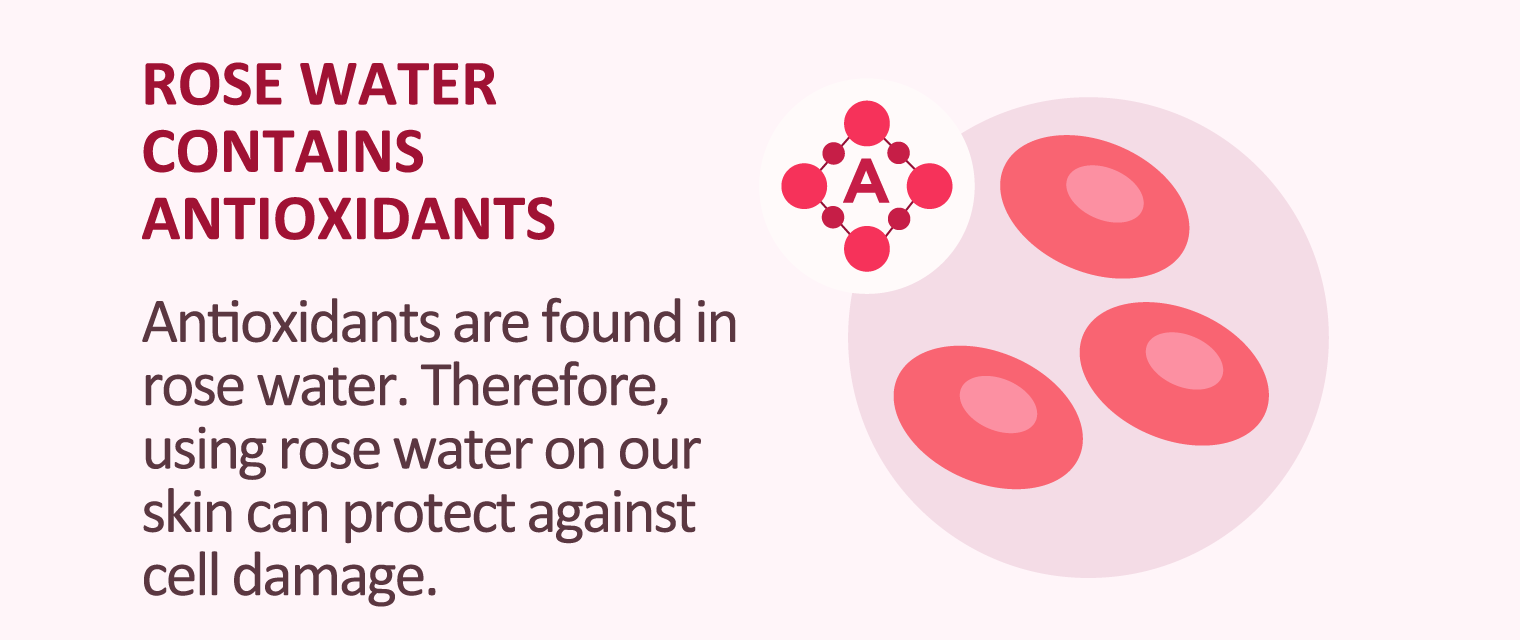
Rose water soothes pharyngitis
Pharyngitis (a sore throat) is a viral infection, such as cold and flu. It causes pain and irritation in the throat, especially when one swallows. Usually, most people do saline water gargles to get relief from the scratchiness that accompanies a sore throat. But rose water can also help soothe pharyngitis. There is strong anecdotal evidence for this remedy, hence making it useful and not likely to be risky.

Rose water has anti-aging effects
Hundreds of beauty products contain rose water in them. It is because of its anti-aging and beauty enhancing impacts that makes it popular in the cosmetic industry.
Topical application of rose water can soothe the skin and make it look more fresh and young.
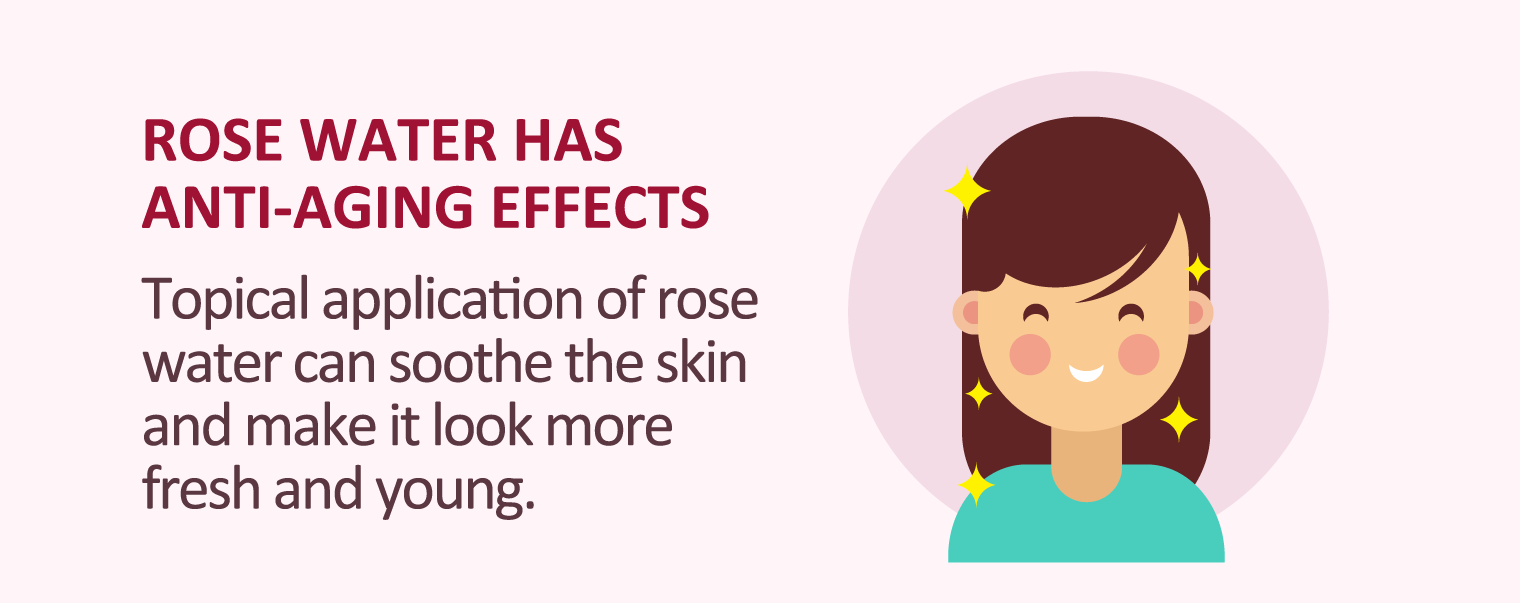
Rose water reduces skin redness
You can significantly reduce erythema by topical application of rose water. Its anti-inflammatory properties reduce swelling and redness around pimples.

Rose water can treat eye infections
Almost every grandma knows about this benefit; rose water treats conjunctivitis (pink eye) – the inflammation of the conjunctiva.
The conjunctiva is a thin, transparent tissue that covers the white part of your eye and also the inner part of the eyelids. A bacterial or viral infection can cause conjunctivitis. The infection results in red eyes, swelling, tears (more than usual), itchy and burning eyes, sensitivity to light, and often a whitish or greenish discharge from the eye.
For hundreds of years, our elders have used rose water to alleviate the symptoms of pink eye. It is a common ingredient in eye drops and other medicines.
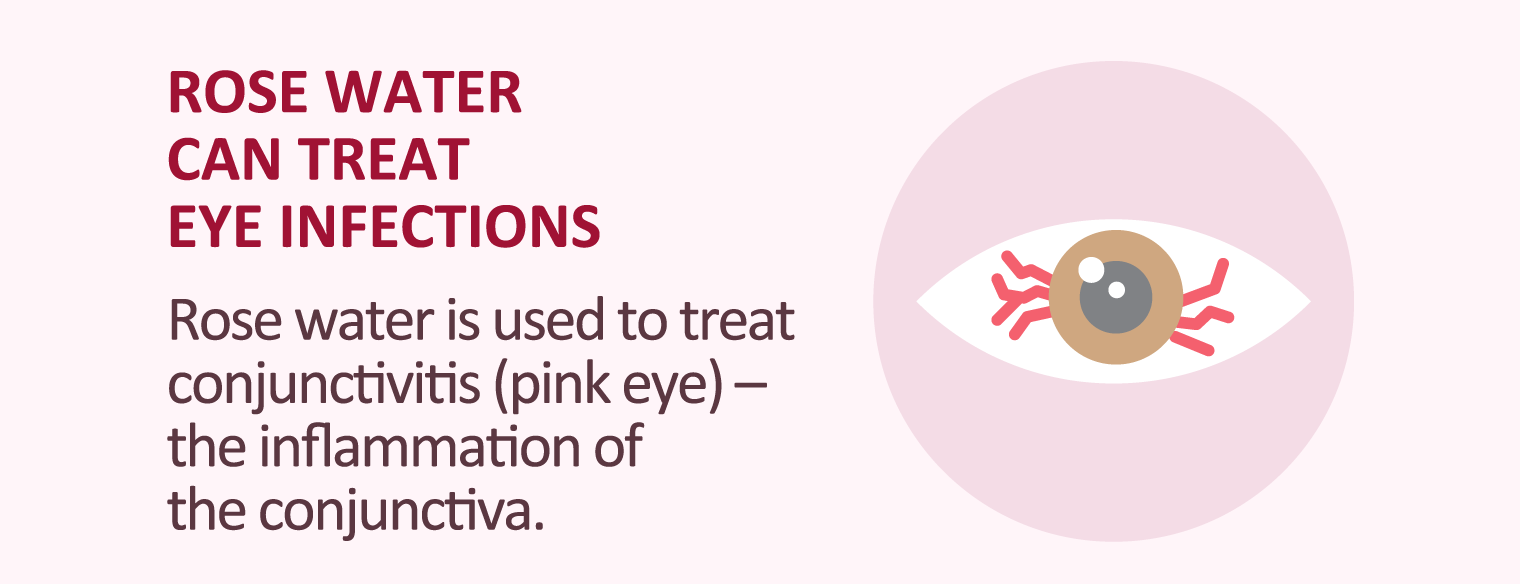
Rose water may help with anxiety and depression
The anti-anxiety and antidepressant properties of rose water are being studied in detail. A 2011 study conducted on mice found that rose water relaxed the CNS, which resulted in antidepressant effects.

Rose water helps relieve headaches
Rose water is a common ingredient in aromatherapy. The de-stressing impact of this water relieves a headache.
Research shows that vapours of rose water can alleviate a headache. For good results, one may also apply a rose-water-soaked-cloth to the head for 30-45 minutes.
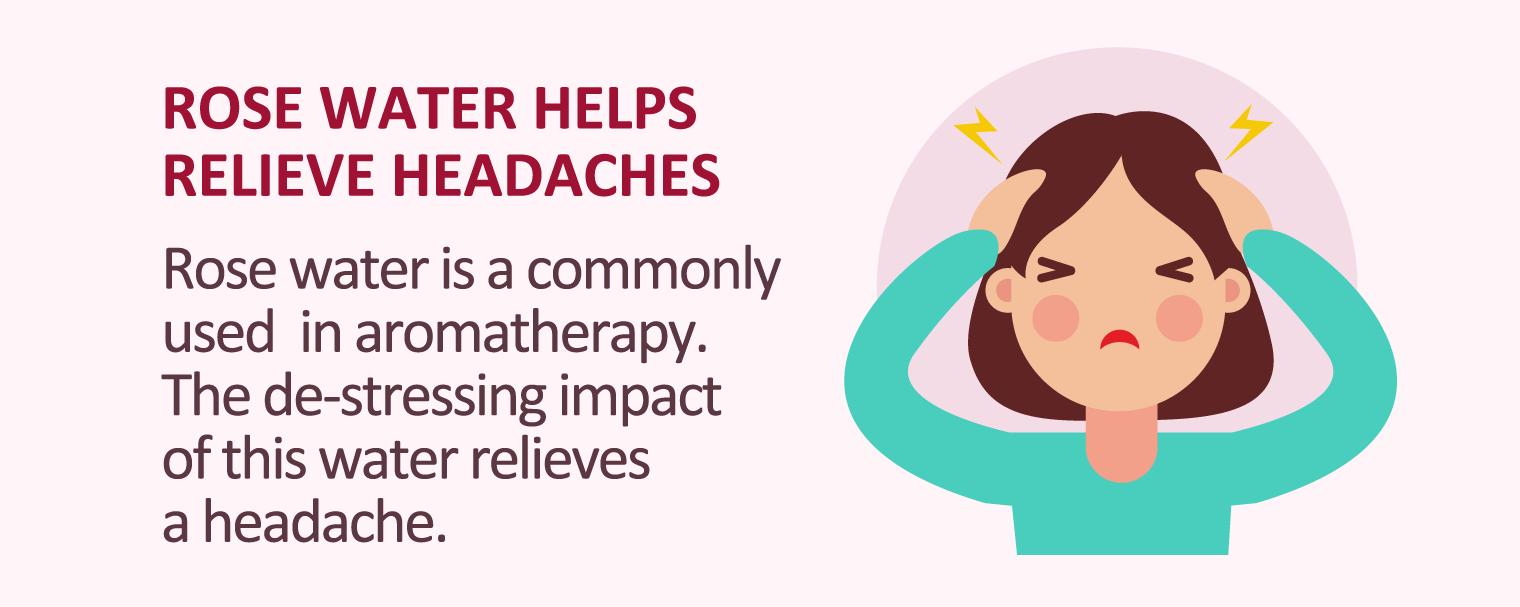
Benefits of rose (essential) oil
A labour-intensive procedure of steam distillation produces rose (essential) oil. Just like rose water, the essential oil is also an age-old remedy for treating health conditions and for enhancing beauty. There are two main benefits of rose essential oil, but before presenting the details of those benefits, let’s take a look at the therapeutic compounds found in it.
In general , research has discovered more than eight compounds with healing properties in rose essential oil. These are as follows:
 Citral
Citral
This compound is common in many cosmetics and personal care products, such as moisturizers, aftershave, perfumes, lotions, and bath products. It also has strong antimicrobial properties and plays a role in vitamin A synthesis.
 Carvone
Carvone
Essential oils from Rosa damascene, spearmint, and seeds of caraway contain carvone, because of its ability to give flavour to the food products and also for air freshening products. It also prevents premature sprouting of stored potatoes. Additionally, essential oils containing carvones are also common in alternative medicine.
 Citronellol
Citronellol
It serves as a mite attractant in insect repellants. Perfume industry also makes use of this compound.
 Citronellyl Acetate
Citronellyl Acetate
It acts as a flavouring agent and fragrance. It gives the aroma of roses, which is why it is common in laundry products, air care items, and many beauty products.
 Eugenol
Eugenol
It has antiseptic and anti-inflammatory properties. Other than its use as a local antiseptic, eugenol is also used in perfumes and flavouring of food.
 Farnesol
Farnesol
It is in floral scents. Farnesol is also a natural pesticide for mites. It might be of surprise to you, but it is one of 599 additives in cigarettes.
 Nerol
Nerol
Nerol, a colourless liquid based off from neroli oil, has a floral odour and serves as a fragrance agent in products.
 Phenylacetaldehyde
Phenylacetaldehyde
It is another flavouring agent and an aromatic compound found in flavoured cigarettes, beverages, and fragrances.
 Phenyl Geraniol
Phenyl Geraniol
It is one of the most common fragrance material and is also common in flavours, such as pineapple, lemon, orange, plum, lime, and blueberry.
Rose essential oil helps against depression
Roses are a perfect sight to better your mood. It is nearly impossible to smell a rose and not smile. Before the days of antidepressants and wide availability of mental health care professionals, small things, such as being close to nature were great strategies to fight the blues. Today, with more options available to us, roses are still a beneficial choice.
Researchers took it upon themselves to find out the real benefits of rose oil. So, they took a sample of 28 postpartum (the period beginning immediately after the baby’s birth) women and divided them into two groups. During the four-week study, group 1 received aromatherapy session twice a week. Aromatherapy involved a mixture of rose oil and lavender oil (2.5 percent solution). Group 2 was a control group.
After four weeks, researchers compared the results from group 1 with the ones from group 2. They discovered that women in group 1 experienced significant decrease in postpartum depression (PPD) scores. They then published the study in the journal, Complementary Therapies in Clinical Practice.
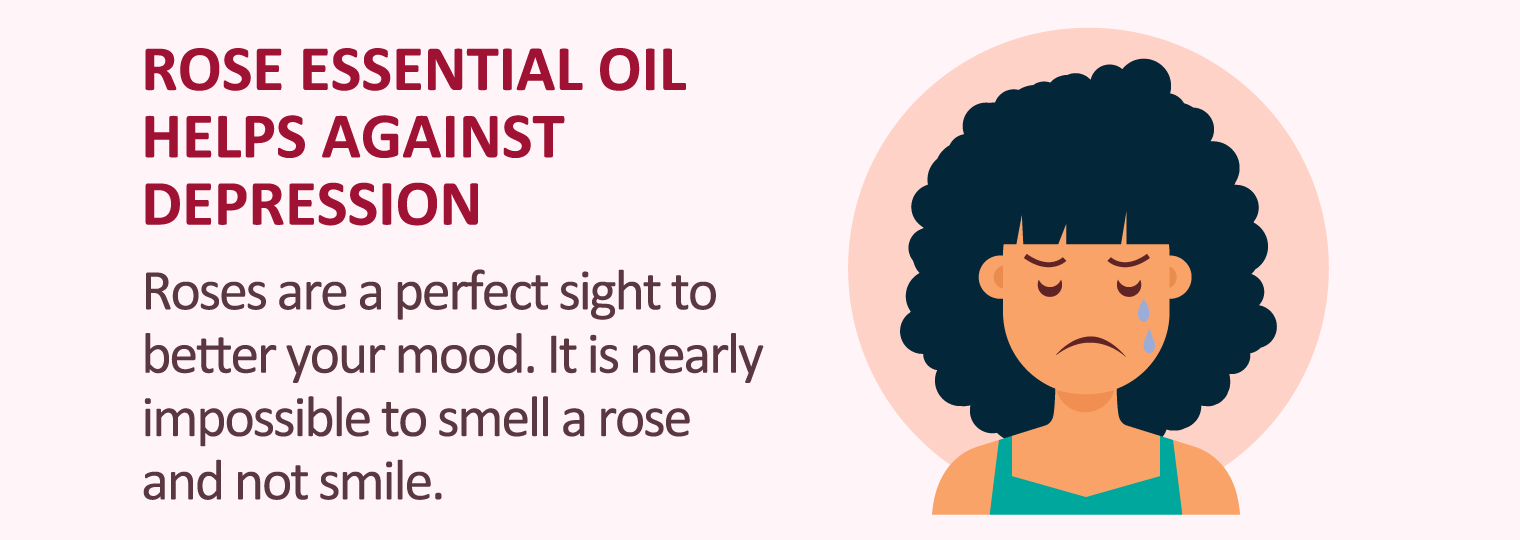
Rose essential oil heals skin
As you have discovered in the “benefits of rose water” section, Damask rose is highly beneficial for skin. The antimicrobial properties of the rose oil are especially suitable for acne prone skin. A 2010 study discovered that rose oil has one of the most potent antibacterial actions when compared to ten other essential oils. They also found out that the application of rose oil (a 0.25% dilution) destroyed the bacteria, Propionibacterium acnes within five minutes. Additionally, Propionibacterium acnes is one of the acne-causing bacteria.
Rose oil also increases the permeability of your skin, and the skin can then absorb more of the healthy nutrients that you apply to your skin.
Skincare products that contain rose oil/rose water can actually be good for your skin. You can also apply rose essential oil directly to the blemishes/pimples with a sterile cotton swab. If you are hesitant in using a 100% pure rose oil, mix it with some coconut oil. That’ll provide the added benefits of coconut oil, for example, moisturizing effect.

What is special about Black Paint Oil Water?
As elaborated earlier, damask rose water and (essential) oil carries many health & beauty benefits. It is also been called “Liquid Gold” because each ounce cost more than an ounce of gold.
When used in skincare, the combined power of damask oil and water can achieve:
- astringent properties to tighten pores giving a smoother complexion.
- antiseptic properties to kill harmful germs and speed up healing from ACNE.
- soothes and calms skin from irritation and inflammation.
- anti-aging and antioxidant properties to combat pigmentation, wrinkles and fine lines.
- fragrance to relieve anxiety and uplifts the mood.
BLACK PAINT created Oil Water, the combination of the best damask water and the best damask oil in the same bottle. Since its launch, it had been the first choice toner of our customers. Oil Water is all-rounded, it is the answer to different skin problem for different ages. It has become the first lotion our customer put on their face immediately after cleansing with our soaps, in their daily skincare regime.
References
https://en.wikipedia.org/wiki/Rosa_×_damascena
https://www.huffpost.com/entry/rose-oil-benefits_b_2633703
https://www.ncbi.nlm.nih.gov/pmc/articles/PMC3586833/
https://draxe.com/rose-essential-oil-benefits-skin-depression-hormones/
https://www.superfoodly.com/benefits-of-rose-oil-for-skin/
https://en.wikipedia.org/wiki/Rose_oil#Production http://www.ncbi.nlm.nih.gov/pubmed/22789792
http://www.mdpi.com/1420-3049/15/5/3200
http://www.ncbi.nlm.nih.gov/pmc/articles/PMC4358691/



 Citral
Citral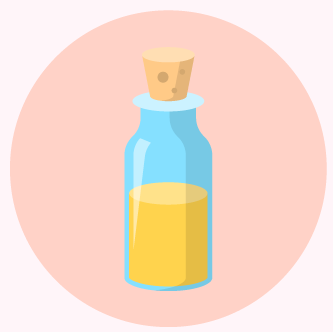 Carvone
Carvone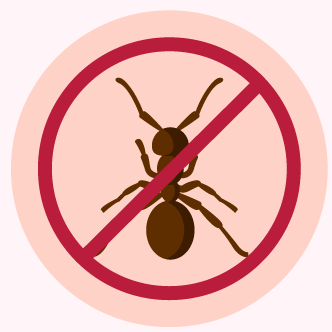 Citronellol
Citronellol Citronellyl Acetate
Citronellyl Acetate Eugenol
Eugenol Farnesol
Farnesol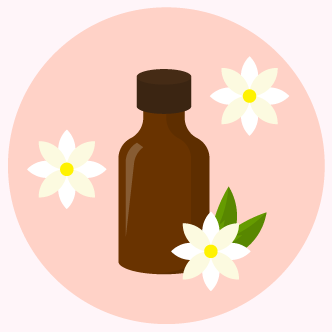 Nerol
Nerol Phenylacetaldehyde
Phenylacetaldehyde Phenyl Geraniol
Phenyl Geraniol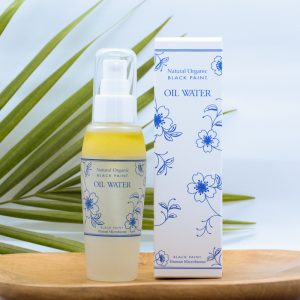 Oil Water
Oil Water



